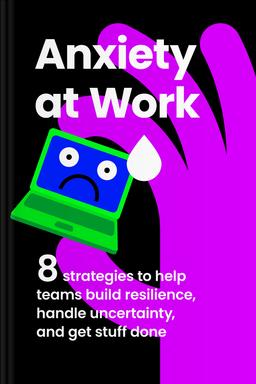You’ll learn
- Why unchecked anxiety can spiral into depression
- How leadership shapes a healthy work environment
- The potential pitfalls of perfectionism
- The difference between worry, stress, and anxiety
russia has launched a full-scale war in Ukraine. Donate to support Ukraine and protect the world’s peace.

first KEY POINT
Anxiety is a persistent, intense, and overpowering fear and dread about certain occurrences, and it results in workplace errors, agitation, and general unwellness. Unfortunately, it is a significant issue that many of today’s employees and employers must deal with.People sometimes think that worry, stress, and anxiety describe the same thing, but they have different meanings, even when used together. Worry is a mental process that includes a lot of repetitive, nagging thoughts. It's usually focused on a specific thing, like the fear of losing your job or wondering if you'll get sick. People feel stress when things change, and the body reacts physically, mentally, or emotionally. Finally, anxiety affects both the body and mind, and it can become a mental disorder in severe cases.Employee anxiety is prevalent in companies, resulting in a rise in workplace concerns since nervous individuals are less likely to be motivated or confident in their abilities at work.
This summary explains the need to pay more attention to people and their behavior and the importance of prioritizing our welfare. In the subsequent chapters, you'll find out more on the seven pressing issues (overwhelming workloads, peer-to-peer learning, perfectionism, discourse, exclusion, and marginalization) that mostly cause anxiety in workplaces and the strategies to help any organization tackle them successfully.
second KEY POINT
Despite their prevalence, employees rarely discuss their workplace worries. People with anxiety are often encouraged to hide it, which often results in depression and leads to what is known as The Duck Syndrome.The term Duck Syndrome was first used at Stanford University to describe how hardworking students appear to be doing fine, floating around like a duck on water and keeping up with all their work with effortless elegance. But when you peek underneath the surface, you'll find that those effortlessly moving ducks are paddling furiously, just like these students are.Take Chloe, for instance. She got a decent career after high school, and her manager saw potential in her because she was hardworking and often smiled. But behind the smile was a young woman who wondered why she had to go the extra mile. Her coworkers had better schooling, wonderful internships, and ample time to vacation and party. But this was not the case for Chloe, who soon became overwhelmed. Afraid she was suffering from anxiety, she confided in her employer, who dismissed it and assured her that it was normal to feel overwhelmed. But Chloe couldn't take it anymore; she simply stopped going to work and never returned to inform anyone.

Continue reading with Headway app
Continue readingfirst KEY POINT
second KEY POINT
third KEY POINT
fourth KEY POINT
fifth KEY POINT